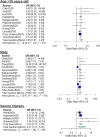Population risk factors for severe disease and mortality in COVID-19: A global systematic review and meta-analysis
- PMID: 33661992
- PMCID: PMC7932512
- DOI: 10.1371/journal.pone.0247461
Population risk factors for severe disease and mortality in COVID-19: A global systematic review and meta-analysis
Abstract
Aim: COVID-19 clinical presentation is heterogeneous, ranging from asymptomatic to severe cases. While there are a number of early publications relating to risk factors for COVID-19 infection, low sample size and heterogeneity in study design impacted consolidation of early findings. There is a pressing need to identify the factors which predispose patients to severe cases of COVID-19. For rapid and widespread risk stratification, these factors should be easily obtainable, inexpensive, and avoid invasive clinical procedures. The aim of our study is to fill this knowledge gap by systematically mapping all the available evidence on the association of various clinical, demographic, and lifestyle variables with the risk of specific adverse outcomes in patients with COVID-19.
Methods: The systematic review was conducted using standardized methodology, searching two electronic databases (PubMed and SCOPUS) for relevant literature published between 1st January 2020 and 9th July 2020. Included studies reported characteristics of patients with COVID-19 while reporting outcomes relating to disease severity. In the case of sufficient comparable data, meta-analyses were conducted to estimate risk of each variable.
Results: Seventy-six studies were identified, with a total of 17,860,001 patients across 14 countries. The studies were highly heterogeneous in terms of the sample under study, outcomes, and risk measures reported. A large number of risk factors were presented for COVID-19. Commonly reported variables for adverse outcome from COVID-19 comprised patient characteristics, including age >75 (OR: 2.65, 95% CI: 1.81-3.90), male sex (OR: 2.05, 95% CI: 1.39-3.04) and severe obesity (OR: 2.57, 95% CI: 1.31-5.05). Active cancer (OR: 1.46, 95% CI: 1.04-2.04) was associated with increased risk of severe outcome. A number of common symptoms and vital measures (respiratory rate and SpO2) also suggested elevated risk profiles.
Conclusions: Based on the findings of this study, a range of easily assessed parameters are valuable to predict elevated risk of severe illness and mortality as a result of COVID-19, including patient characteristics and detailed comorbidities, alongside the novel inclusion of real-time symptoms and vital measurements.
Conflict of interest statement
A.B, A.B.R., S.P., D.P., A.Y., M.A., are employees of Huma Therapeutics Ltd. D.M & AL declare that they have no conflict of interests to report. This does not alter our adherence to PLOS ONE policies on sharing data and materials.
Figures




Similar articles
-
Primary Care Relevant Risk Factors for Adverse Outcomes in Patients With COVID-19 Infection: A Systematic Review.J Am Board Fam Med. 2021 Feb;34(Suppl):S113-S126. doi: 10.3122/jabfm.2021.S1.200429. J Am Board Fam Med. 2021. PMID: 33622826
-
Mortality-related risk factors of COVID-19: a systematic review and meta-analysis of 42 studies and 423,117 patients.BMC Infect Dis. 2021 Aug 21;21(1):855. doi: 10.1186/s12879-021-06536-3. BMC Infect Dis. 2021. PMID: 34418980 Free PMC article.
-
Obesity is associated with increased severity of disease in COVID-19 pneumonia: a systematic review and meta-analysis.Eur J Med Res. 2020 Dec 2;25(1):64. doi: 10.1186/s40001-020-00464-9. Eur J Med Res. 2020. PMID: 33267871 Free PMC article.
-
Sutureless Aortic Valve Replacement for Treatment of Severe Aortic Stenosis: A Single Technology Assessment of Perceval Sutureless Aortic Valve [Internet].Oslo, Norway: Knowledge Centre for the Health Services at The Norwegian Institute of Public Health (NIPH); 2017 Aug 25. Report from the Norwegian Institute of Public Health No. 2017-01. Oslo, Norway: Knowledge Centre for the Health Services at The Norwegian Institute of Public Health (NIPH); 2017 Aug 25. Report from the Norwegian Institute of Public Health No. 2017-01. PMID: 29553663 Free Books & Documents. Review.
-
Social inequalities and nutritional disparities: the link between obesity and COVID-19.Eur Rev Med Pharmacol Sci. 2022 Jan;26(1):320-339. doi: 10.26355/eurrev_202201_27784. Eur Rev Med Pharmacol Sci. 2022. PMID: 35049011 Review.
Cited by
-
Outcomes of coronavirus disease 2019 (COVID-19) and risk factors associated with severe COVID-19 in patients with mature B-cell non-Hodgkin lymphomas: A US electronic health record cohort study.Eur J Haematol. 2023 Feb;110(2):177-187. doi: 10.1111/ejh.13891. Epub 2022 Nov 15. Eur J Haematol. 2023. PMID: 36319588 Free PMC article.
-
Complex patterns of multimorbidity associated with severe COVID-19 and Long COVID.medRxiv [Preprint]. 2024 Jul 1:2023.05.23.23290408. doi: 10.1101/2023.05.23.23290408. medRxiv. 2024. Update in: Commun Med (Lond). 2024 Jul 8;4(1):94. doi: 10.1038/s43856-024-00506-x. PMID: 39006431 Free PMC article. Updated. Preprint.
-
Long COVID Clusters of Symptoms Persist beyond Two Years after Infection: Insights from the CARDIO COVID 20-21 Registry.Viruses. 2024 Jun 26;16(7):1028. doi: 10.3390/v16071028. Viruses. 2024. PMID: 39066191 Free PMC article.
-
Direct Detection of Glycated Human Serum Albumin and Hyperglycosylated IgG3 in Serum, by MALDI-ToF Mass Spectrometry, as a Predictor of COVID-19 Severity.Diagnostics (Basel). 2022 Oct 17;12(10):2521. doi: 10.3390/diagnostics12102521. Diagnostics (Basel). 2022. PMID: 36292212 Free PMC article.
-
A beacon in the dark: COVID-19 course in CVID patients from two European countries: Different approaches, similar outcomes.Front Immunol. 2023 Feb 8;14:1093385. doi: 10.3389/fimmu.2023.1093385. eCollection 2023. Front Immunol. 2023. PMID: 36845159 Free PMC article.
References
-
- WHO. Weekly epidemiological update—17 November 2020. World Health Organization; 2020. Nov. Available: https://www.who.int/publications/m/item/weekly-epidemiological-update—17...
Publication types
MeSH terms
Grants and funding
LinkOut - more resources
Full Text Sources
Other Literature Sources
Medical
Miscellaneous

